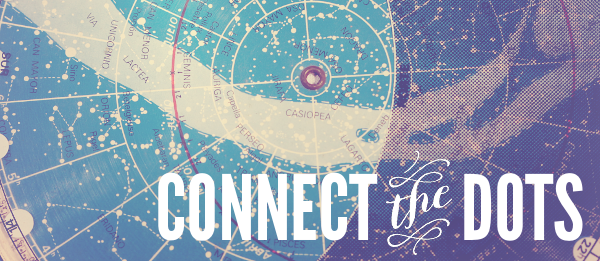Connect the Dots
By Jessica Albon

Star Chart by Miguel Saavedra
Last week, I shared something deeply personal with my newsletter list. And it’s funny, as hard as writing the post and clicking publish was, there was something that was even harder:
Not relating it back to your business.
Usually, what I share here is actionable, practical, and hands-on. I often challenge you to use what I’m offering in some specific, tangible way. And I had a couple different ideas for how losing my home when I was a kid sharing your message.
But I didn’t.
Because there’s something that I tell my clients often, but that when it comes to my own writing, I find it nearly impossible to trust.
If you write each sentence to be the truest sentence that you can muster… If you follow the story you’re telling from beginning to end… If you share what you most need to share in that moment…
You can release what you’ve written knowing that the readers who need it will get what they need from it.
I like to tie things up in a bow for you. I like to lead you through the article and wrap it in soundbite.
And there’s nothing wrong with that until it becomes the only way I’m comfortable communicating with you.
See, when I take full responsibility for every aspect of what happens when you and I are communicating, I’m not letting you participate. Not really. Real communication is a two-way street, us meeting each other half way, and doing our best to understand and be understood.
But in a world where readers are busy and distracted, and where there are a million different ways to be misunderstood, I tend to take too much responsibility. I want you to have the best experience possible, and the result can be that I try to control the communication.
That’s one of the pitfalls of having Elizabeth Taylor as my Brand Siren (maybe you can relate).
So, today, I want to talk about Connecting the Dots. Because chances are, it’s something you’re either like me with and you do it more than is necessary, or you’re on the opposite end of the spectrum and you don’t do it nearly enough.
The drawback of doing too much Connecting the Dots is that you don’t ever let your readers practice understanding you. You don’t really let them see you because it’s always this wrapped up, tied-in-a-bow experience for them.
And the drawback of not doing enough Connecting the Dots is that you start to look either flaky or arrogant. It makes you look flaky because you jump from topic to topic without ever bringing it back to the central point. So, you might talk about music one week and you might tell a story about chimney sweepers the next, and if you don’t relate that back to your mission, your readers think you’re just jumping around from interest to interest.
But, if you take a moment and wrap it up for readers, and explain the way music relates to what you do, and the way chimney sweeping relates to what you do, your readers will get it and they’ll see the bigger picture right there with you.
Not Connecting the Dots makes you look arrogant when you make a lot of big, bold statements, but never really explain them. Proclaiming, for instance, “Taste the Clever!” instead of writing an article about how to do that and what that means, can make your readers feel like you’re always lecturing them.
Your Brand Siren will often reveal whether your tendency is to Connect the Dots too often, not often enough, or just right. Here’s the full spectrum.

Notice Elizabeth and Audrey tend to Connect the Dots more often than necessary. That leads you to feel like you’re over explaining. Sometimes, you see people’s eyes glaze over when you’re giving them information you know they actually need (and want!). This is exhausting–it’s like you’ve taken full responsibility for whether or not the other person “gets” it, when the fact is, that’s their job.
Edith and Judy fall to the opposite end of the spectrum. This leads you to come across as arrogant or flighty. You might feel like people don’t take you seriously, or they don’t seem to understand how what you’re saying relates to them. They may tend not to trust you, or to believe what you say.
Do you see how our Brand Sirens can really help us get clear on where we’re getting stuck with our communications? It makes those blind spots come into sharp focus so that we can fix them.
When it comes to Connect the Dots, which end of the spectrum are you on?
Blog






